
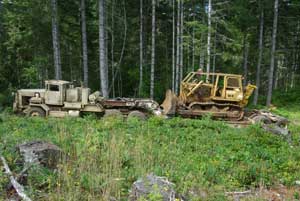
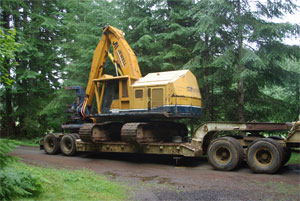
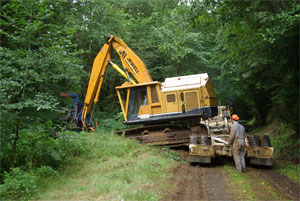
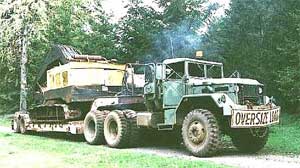

|
| All photos with blue borders expand if clicked |
| Fiat Allis 31 above |

|
| HD 16B Riding |

|
| Going for a Ride |

|
| Yutani 320 Getting Off |

|
| Hopto 900 Riding |
Here you will find a General 10 foot wide Lowboy matched to the M911. Also featured here is a Hopto 900a going for a ride through the back forty on a 70 ton General Trailer Lowboy behind a modest 6X6 which is also known as a M123A1C Army 10 tonner (which is really a Mack Truck assembled by Consolidated Diesel ) rated that way because the Army figured that equipped with a bed instead of a 5th wheel this truck would haul 10 tons anywhere it would stay right side up Oh well!
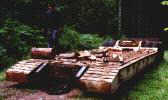
|
| Ready To Load |
General Trailer of Eugene, Oregon made trailers for the timber industry for a long time. They have made lines of belly dumps, lowboys, as well as log trailers. Featured here is a ground bearing on/off highway lowboy rated at 70 tons. It is 10 feet wide and equipped for extensions to make it wider. It features 12X24 rubber on the back and was built for 'water on the brakes' though we don't use that feature. The wheels feature the large center rings and oversize lug bolts. The wheels are inter changeable with the truck, but the 14x24 truck tires won't work on the trailer because the walking beams are not long enough.
Lowboys are called that because the bed is of a 'drop center' design. This means that the bed is lower in the front of the rear wheels and then rises sharply at the front to reach up over the rear of the truck. This front section which bends up over the rear of the truck is called the "goose neck'. This type of trailer is used commonly for heavy hauling because you can get a larger load closer to the ground than would be possible on a 'flat bed' trailer so called because the bed is 'flat' and extends from a point over the rear tires forward over the fifth wheel.
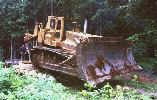
|
| Back easy! |
| See the guy behind |
The challenge of a lowboy, of course is getting it loaded or unloaded. There are more or less 3 ways to load/unload lowboys- over the back, over the sides or over the front. Each has its problems. If you load over the rear you have to drive the load up over the tires and the back of the trailer and then down into the 'well'. This approach is simple in theory, but it means that you have to get what ever you are loaded 4 feet up in the air and then somehow drive it over the trailers tires and down into the well. Easier said than done, especially if it is a bit wider than the trailer. The second alternative is to load over the side. It is a little hard on the trailer because at some point who have the whole load tittering on one side of the trailer but it is quick. The problem is that you generally have to turn the machine 90 degrees after you drive it on the trailer and if what you are loading won't make a 90 degree turn on a 10 foot wide trailer loading over the side doesn't get you there.
All of these problems have lead the trailer makers to invent 'removable or folding goose neck' trailers. There are a number of designs, but the concept is the same. You lay the front end of the trailer flat on the ground and either disconnect the goose neck or fold it flat on the ground and use it for a loading ramp. You then move the truck out of the way and load the machine by driving it onto the trailer over the front of the trailer. You then hook the truck back to the trailer and you are off and away.
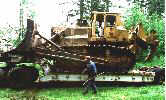
|
| Buttoned up |
Different manufacturers have had a number of 'better ideas' for how to accomplish this. One of the problems is, of course, that the front of the trailer is laying on the ground. This makes it easier to load, but you have to get it up off the ground to rehitch it to the truck. I've seen some designs which used a tapered goose neck and they contemplated that you would simply charge the trailer with the truck in high speed reverse and the goose neck would slide up a tapered ramp on the back of the truck and eventually lock into the fifth wheel. It is a slam bang solution which requires no hydraulics.
The ground bearing design such as the one shown here has hydraulic feet under the front of it. You load the trailer, lift the front of the trailer on hydraulic cylinders and then back the truck up to the front of the uplifted trailer and latch the goose neck (which is hanging in the fifthwheel and propped on the back of the truck) to the trailer. You then retract the hydraulic jackstand and you are off and away. The system has 2 problems. First is the location of the hydraulic pump. Where do you put it. Heavy haulers like hydraulic pumps driver off the truck engine (called a wet kit) because it saves having a second engine somewhere. Alternatively you must have about a 10 horse gas engine and hydraulic pump and tank mounted on the trailer somewhere, but where. Usually, by the process of elimination you end up locating the pump and engine up on the front of the goose neck because that is the only place you can find to put it. The trailer is too low to put anything under it and any place else is in the way.
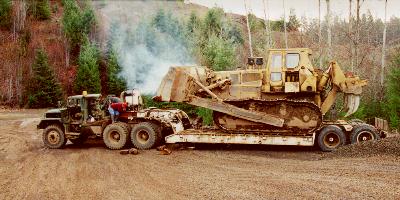
|
| Preparing to Unload |
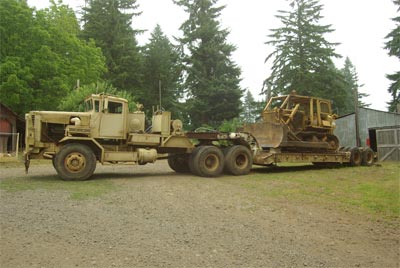
|
| Fiat Allis 16B |
The nuisance is that either way (with a wet kit) or a pump on the gooseneck) you have hydraulic lines running to the trailer because that is where the hydraulic jack stand is. This is one more thing besides your electric cable, and air lines that has to be disconnected before you can drive away. The other problem with a 'jack stand' lowboy is that many of them sort of assume that you will always be loading on hard dry surfaces. If the jackstand pushing into the ground instead of lifting the trailer you have a problem, and the weight is very substantial. For example, with this 70 ton lowboy you might need to lift as much as 35 tons and one needs to think about how much ground surface in soft ground is required to support that weight. I've seen lowboys with a single lift cylinder with a 12" square pad on it. Those will push a hole right into a paved road. This particular general model has a 12" channel iron completely across the front of the trailer with a cylinder on each end. We put some wooden blocking under the ends of the channel for additional ground bearing and hope for the best. This lifter is better than some and worse than others.
Another problem that you can have with some trailers is getting them latched even after they are lifted. Some latches are susceptible to twist and if one side of the trailer is higher or lower than the other as compared to the truck the trailer won't go together. Trailers with latches on the our side rails seem to be worse about this.
The most progressive designs, and the ones that I suspect are the best (and are showing up more and more) are of a non-ground bearing variety. The goose neck detaches for loading and the trailer lays on the ground, but the lifting linkage is in the goose neck. You just back up to the trailer and the goose neck reaches down, snags the front of the trailer and pulls up up into position and latches it there. These 'smart goose neck' require no hydraulics in the trailer so either a truck wet kit or a goose neck mounted hydraulic pump is convenient.
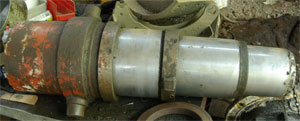
|
| Lift cylinder from General Trailer |
Others have hydraulic systems. Our particular model has a 'jack stand lift' which lifts the front of the trailer so the goose neck can be attached. The jack stand is operated by a couple of short multistage hydraulic cylinders under the front corners of the trailer.
A critical part of each extension cylinder is the spanner nut on the end of each stage. It holds the packing and wiper in place, which is sort of stuffed in the space between the stages, and also keeps the inner stages in alignment. The bottom spanner nut is trashed on this cylinder so we will be attempting to make a new one. Stay tuned.